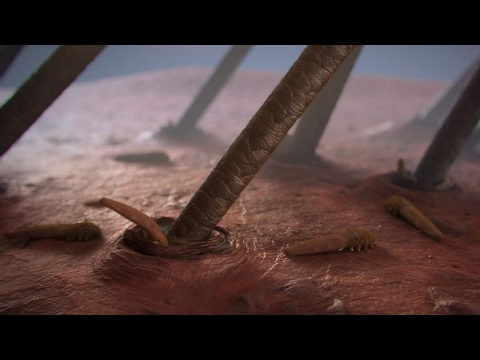
Demodectic mange are a type of tiny mites that can infest the skin of a dog. Puppies and dogs with weakened immune systems are especially susceptible to demodex. There also appears to be quite a bit of confusion about how a dog can get demodex.
Demodex is diagnosed with a skin scraping inspected under a microscope for presence of the actual mites. Typical symptoms include balding spots on the fur, itchiness, redness, and general discomfort.
The simplest way to think of demodex is to think of the mites as a pathogen – such as the common cold virus or some airborne bacteria. Everyone is exposed to this type of viruses or the bacteria – they are all around us in the environment. But – you only get afflicted by that virus/bacteria when your immune system is not strong enough to immediately respond and prevent the infection. That is also how demodex mites work – they are able to infest dogs with weakened immune systems. There are a lot of questionable claims regarding demodex being transmitted from the nursing mother to her puppies. That argument falls apart when you hear of and actually observe the following situations:
Demodex mites used to be a difficult problem to address in dogs, especially once an infestation becomes widespread enough to be considered generalized demodecosis, rather than a localized demodecosis.
However, this is no longer the reality due to advents of two medicines, both of which were developed as flea/tick medications but inadvertently were found to be extremely effective at killing demodex, even of the generalized variety.
They are Bravecto (fluralaner) and NexGard (afoxolaner). The effectiveness of Bravecto especially, in just one orally administered dose, is simply mind-blowing.
Bravecto (fluralaner):
“After single oral administration of Bravecto™ chewable tablets, mite numbers in skin scrapings were reduced by 99.8% on Day 28 and by 100% on Days 56 and 84.”
Source: Efficacy of orally administered fluralaner (Bravecto™) or topically applied imidacloprid/moxidectin (Advocate®) against generalized demodicosis in dogs.
NexGard (afoxolaner):
“Afoxolaner was administered at the recommended dose (at least 2.5 mg/kg) on Days 0, 14, 28 and 56. […] The percentage reductions of mite counts were 99.2%, 99.9% and 100% on Days 28, 56 and 84, respectively, in the afoxolaner-treated group”
Source: Efficacy of oral afoxolaner for the treatment of canine generalised demodicosis
The major difference to note between these two medications is that NexGard can be administered to dogs 2 months or older and needs to be administered monthly, while Bravecto can only be administered at 6 months of age or older, but only needs to be administered once every 3 months.
For further reading about how certain common medications may affect your puppy’s immune system and specific precautions to take concerning the timing of administration, we recommend this page: Vaccinations, Deworming, and Flea Medication
Image © by its respective owners. Image produced for educational purposes.
